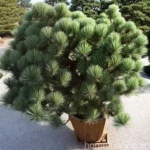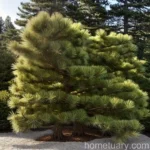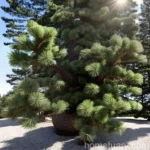Eastern White Pine (Pinus strobus ‘Pendula’)
Eastern white pine (Pinus strobus ‘Pendula’) is a unique and aesthetically pleasing cultivar known for its weeping nature. As a plant scientist, I am thrilled to delve into this stunning tree, exploring its key characteristics, culture, uses, and maintenance. In this comprehensive guide, we will cover everything from planting tips to disease resistance, providing you with all the essential information for successfully growing and maintaining the eastern white pine.
What is Eastern White Pine (Pinus strobus ‘Pendula’)?
The eastern white pine, scientifically known as Pinus strobus ‘Pendula’, is a variety of the white pine species, lauded for its distinct pendulous growth habit. This beautiful ornamental tree boasts gracefully drooping branches that create an elegant and dramatic silhouette in the landscape. Its weeping form sets it apart from its upright counterparts, adding a touch of romance and whimsy to any garden or outdoor setting.
As a plant scientist, I appreciate the unique charm that Pinus strobus ‘Pendula’ brings to horticulture. Its characteristic weeping branches make it a standout feature in gardens, parks, and other green spaces, captivating the eye with its soft, cascading foliage.
Key Takeaways – Eastern White Pine (Pinus strobus ‘Pendula’)
Before we delve deeper into the diverse aspects of the eastern white pine tree, let’s summarize the key takeaways that we will explore in detail:
- Culture
- Uses
- Water
- Sunlight
- Fertilizer
- Soil
- Pruning
- Propagation
- Container Popularity
- Container Common Diseases
- Disease Diagnosis
- Common Pests
- Botanist’s Tips
- Fun Facts
- Links to External Resources
Now let’s embark on an in-depth journey to understand the nuances of growing, maintaining, and enjoying the beauty of the eastern white pine.
Culture
Understanding the cultural needs of Pinus strobus ‘Pendula’ is crucial for ensuring its vitality and longevity. Let’s explore the key cultural aspects, including water requirements, sunlight preferences, fertilizer needs, soil conditions, and pruning practices.
Water
Proper watering is essential for the health and vigor of the eastern white pine. While it is important to provide adequate moisture, it is equally crucial to ensure good drainage to prevent waterlogged soil, which can lead to root rot and other detrimental conditions.
-
Watering Needs: Eastern white pine trees generally prefer evenly moist soil, especially during their establishment phase. Regular watering, particularly during dry spells, is essential to support healthy growth and vitality.
-
Deep Watering: When watering the tree, it is advisable to water deeply, allowing the moisture to penetrate the soil and reach the root zone. Shallow watering may result in shallow root development, making the tree more susceptible to drought stress.
-
Mulching: Applying a layer of organic mulch around the base of the tree can help conserve soil moisture, regulate soil temperature, and inhibit weed growth. Mulching also adds a decorative element to the landscape while benefiting the tree’s overall health.
Sunlight
As with many plants, sunlight plays a pivotal role in the growth and development of Pinus strobus ‘Pendula’. Understanding its sunlight requirements is essential for optimizing its performance in the landscape.
-
Sun Exposure: Eastern white pine trees thrive in full sun to partial shade. While they prefer ample sunlight for robust growth, they can also tolerate some shade, making them versatile additions to various garden settings.
-
Optimal Placement: When selecting a planting location, consider providing the tree with adequate sunlight exposure while taking into account the local climate and environmental conditions. Proper placement can contribute to the tree’s overall health and visual appeal.
Fertilizer
Fertilization can bolster the growth and vitality of the eastern white pine, providing essential nutrients for its development. However, it is important to apply fertilizers judiciously and in accordance with the specific needs of the tree.
-
Timing: It is advisable to fertilize the tree in early spring, before the onset of new growth. This timing allows the tree to benefit from the added nutrients as it enters its active growing phase.
-
Balanced Fertilizer: Consider using a balanced fertilizer formulated for evergreen trees, ensuring that it provides the necessary macro and micronutrients. Application rates should align with the manufacturer’s recommendations and the tree’s current state of health and growth.
-
Soil Testing: Conducting a soil test can provide valuable insights into the nutrient levels and pH of the soil, guiding you in making informed decisions regarding fertilization. Adjusting the soil’s nutrient composition based on the results of a soil test can contribute to the tree’s overall well-being.
Soil
The soil composition and structure significantly influence the health and growth of Pinus strobus ‘Pendula’. Understanding the soil requirements and making suitable amendments can create an optimal growing environment for the tree.
-
Well-Drained Soil: Eastern white pine trees thrive in well-drained, loamy soil. Soil that retains moisture while allowing excess water to drain away is ideal for supporting the tree’s root system and overall health.
-
pH Level: The ideal soil pH for eastern white pine trees ranges from slightly acidic to neutral. Conducting a soil test can help determine the current pH level and guide any necessary soil amendments to create a favorable growing media.
-
Soil Amendment: Incorporating organic matter, such as compost or well-rotted manure, can enhance the soil structure, fertility, and moisture retention capacity. Amending the soil at the time of planting or as a top-dressing can benefit the tree’s root development and overall well-being.
Pruning
Proper pruning can help maintain the structure, health, and aesthetics of Pinus strobus ‘Pendula’. While its weeping growth habit offers an inherently graceful appearance, judicious pruning can enhance its form and longevity.
-
Pruning Technique: When pruning the eastern white pine, it is important to use clean, sharp pruning tools to make precise cuts. Remove any dead, damaged, or diseased branches, and consider shaping the tree to maintain its desired form.
-
Timing: The best time to prune the eastern white pine is in late winter to early spring, before the onset of new growth. Pruning during this period minimizes stress on the tree and allows for optimal healing of pruning wounds.
-
Minimizing Stress: Avoid excessive pruning, particularly of healthy branches, as this can lead to stress and compromise the tree’s natural vigor. Focusing on selective and minimal pruning can help preserve the tree’s overall health and aesthetic appeal.
Propagation
For those interested in propagating Pinus strobus ‘Pendula’, understanding the propagation methods and best practices can open up avenues for expanding its presence in gardens and landscapes.
-
Seed Propagation: Eastern white pine trees can be propagated from seeds, which are typically found within the cones. Collecting mature cones, extracting the seeds, and following proper germination techniques can yield new seedlings for propagation.
-
Cutting Propagation: Softwood or hardwood cuttings can also be used to propagate the weeping white pine. Utilizing healthy, disease-free cuttings and providing suitable rooting conditions can lead to successful propagation.
-
Rooting Hormone: When propagating from cuttings, a rooting hormone may be applied to facilitate the development of roots. The hormone encourages root growth and enhances the cutting’s ability to establish itself as a new plant.
Uses
The versatility of Pinus strobus ‘Pendula’ extends beyond its ornamental value, encompassing various uses and applications in landscaping and horticulture. Understanding its potential roles can inspire creative and purposeful integration into diverse outdoor spaces.
Ornamental Feature
The weeping white pine serves as a captivating ornamental feature in gardens, parks, and estates. Its graceful form and elegant foliage lend a sense of tranquility and sophistication to the landscape, making it a prized addition to curated garden designs and naturalistic settings.
Specimen Tree
When planted as a specimen tree, Pinus strobus ‘Pendula’ takes center stage, commanding attention with its cascading branches and distinctive silhouette. It can serve as a focal point in the landscape, drawing the eye and creating a captivating focal point in both residential and public spaces.
Screening and Privacy
The weeping nature of the eastern white pine can be leveraged to create natural screens or privacy barriers. When planted strategically, it can provide a visually soft and appealing boundary, offering seclusion and visual interest while delineating outdoor spaces.
Container Planting
In addition to its role in traditional gardens and landscapes, the weeping white pine can thrive in containers, adding vertical interest and greenery to patios, balconies, and other outdoor living areas. Container planting allows for versatility in placement and can enhance outdoor aesthetics in various settings.
Common Diseases
As a plant scientist, I recognize the importance of disease management and prevention in maintaining the health and vigor of ornamental plants such as Pinus strobus ‘Pendula’. While this cultivar exhibits good resilience, it is essential to be aware of potential diseases that may affect its well-being.
Disease Diagnosis
Some common diseases that may impact the eastern white pine include:
-
White Pine Blister Rust: This fungal disease can lead to the formation of cankers on the tree’s branches and trunk, potentially causing dieback and decline.
-
Dothistroma Needle Blight: Characterized by browning and premature shedding of needles, this fungal disease can affect the tree’s overall appearance and vitality.
-
Needle Cast: Various fungal pathogens can cause needle cast diseases, leading to the discoloration, browning, and defoliation of the tree’s needles.
-
Root Rot: Excessive moisture and poorly drained soil can create favorable conditions for root rot pathogens, which may impact the tree’s root system and overall health.
Disease Management
While maintaining optimal cultural practices can enhance the tree’s natural resistance to diseases, proactive management strategies can further mitigate potential risks. These strategies may include:
-
Monitoring: Regularly inspect the tree for any signs of disease, including changes in foliage color, dieback, or unusual blemishes on the bark.
-
Cultural Practices: Implement proper watering, pruning, and fertilization practices to promote the tree’s overall health and resilience to potential diseases.
-
Sanitation: Promptly remove any diseased or fallen plant material, as well as affected branches, to prevent the spread of pathogens and minimize disease pressure.
-
Integrated Pest and Disease Management: Consider adopting integrated approaches that may involve the use of disease-resistant cultivars, biological controls, or targeted treatments in response to specific disease threats.
Common Pests
While Pinus strobus ‘Pendula’ is generally resilient to many pests, vigilance is crucial for identifying and addressing potential pest infestations that may compromise the tree’s health and appearance.
Potential Pests
Common pests that may pose a threat to the eastern white pine include:
-
Pine Sawfly: The larvae of sawflies may feed on pine needles, potentially causing defoliation and impacting the tree’s overall vigor.
-
Pine Needle Scale: Scale insects can infest the needles of the tree, leading to discoloration and reduced photosynthetic capacity.
-
Adelgids: Certain species of adelgids may infest white pines, affecting new growth and leading to the formation of galls or abnormal growths on the tree.
Pest Management
Employing integrated pest management practices can help address potential pest issues while minimizing the use of chemical interventions. These strategies may include:
-
Monitoring: Regularly inspect the tree for signs of pest activity, including the presence of insects, abnormal growths, or damage to the foliage.
-
Natural Predators: Encourage the presence of natural predators and beneficial insects that can help control pest populations through biological means.
-
Pruning: Remove and destroy heavily infested branches and plant material to reduce pest pressure and limit the spread of infestations.
-
Selective Treatments: If pest populations reach concerning levels, consider targeted treatments using insecticidal soaps, horticultural oils, or other low-impact interventions.
Botanist’s Tips
As a botanist specializing in plant science, I offer the following tips for cultivating and caring for Pinus strobus ‘Pendula’:
-
Selecting a Planting Site: Choose a well-drained location with ample sunlight to promote healthy growth and the development of the weeping white pine.
-
Soil Preparation: Prior to planting, amend the soil with organic matter to improve its structure, fertility, and drainage capabilities.
-
Moderate Watering: Aim for consistent moisture, avoiding waterlogged or excessively dry conditions while providing suitable drainage.
-
Pruning Considerations: Practice minimal and selective pruning to maintain the tree’s natural form and prevent excessive stress.
-
Integrated Care: Complement proper cultural practices with vigilant monitoring and proactive pest and disease management to uphold the tree’s well-being.
-
Regular Maintenance: Stay attuned to the tree’s needs throughout the seasons, providing ongoing care and attention to support its long-term health and vitality.
Fun Facts
To delight in the allure and appeal of Pinus strobus ‘Pendula’, here are some captivating fun facts about this remarkable tree:
-
Historical Significance: The eastern white pine holds historical significance, as it was once a coveted timber species for shipbuilding and other construction purposes.
-
State Tree: In several U.S. states, including Maine and Michigan, the eastern white pine serves as the official state tree, symbolizing its cultural and ecological importance.
-
Wildlife Habitat: The tree’s dense foliage and sheltering branches provide valuable habitat and nesting sites for various bird species and small mammals.
-
Symbolism: Eastern white pines are often associated with longevity, resilience, and natural beauty, reflecting their enduring presence in forests and landscapes.
Links to External Resources
For further exploration and in-depth information on eastern white pine (Pinus strobus ‘Pendula’), refer to the following external resources:
- USDA Plants Database – Pinus strobus
- The Morton Arboretum – Eastern White Pine
- University of Florida IFAS Extension – White Pine Blister Rust
- Penn State Extension – Dothistroma Needle Blight of Pines
- Integrated Pest Management for Home Gardeners – Pine Sawflies
I hope this comprehensive guide has provided you with valuable insights into the captivating world of eastern white pine (Pinus strobus ‘Pendula’) and the various aspects of its cultivation, uses, and maintenance. As a plant scientist, I encourage you to explore the beauty and botanical marvels that adorn our natural surroundings, fostering an appreciation for the diversity and splendor of the plant kingdom.















